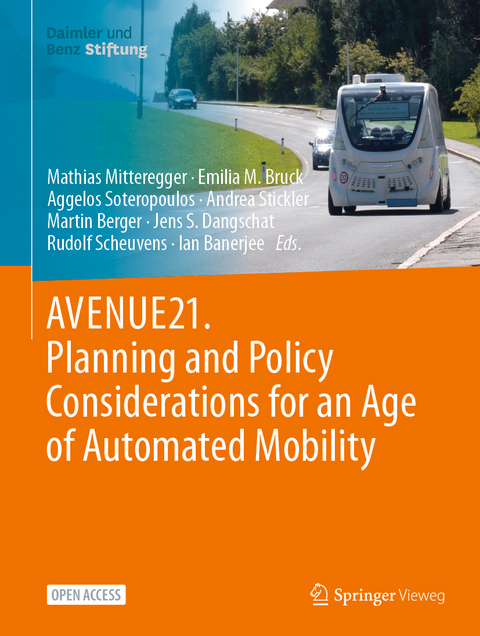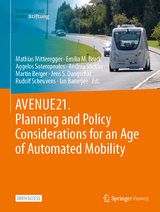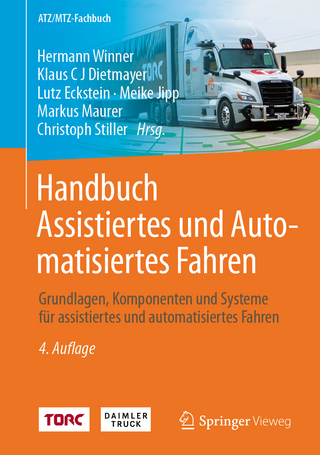AVENUE21. Planning and Policy Considerations for an Age of Automated Mobility
Springer Berlin (Verlag)
978-3-662-67003-3 (ISBN)
- Lieferbar (Termin unbekannt)
- Versandkostenfrei innerhalb Deutschlands
- Auch auf Rechnung
- Verfügbarkeit in der Filiale vor Ort prüfen
- Artikel merken
The subject of this open-access publication is the impact of connected and automated vehicles on the European city and the conditions under which this technology can make a positive contribution to urban development. The authors put forward two theses that have received little attention in the scientific discourse so far: Connected and automated vehicles will not become fully established in all sub-areas of the city for a long time. As a result, previously assumed effects - from traffic safety to traffic performance as well as spatial effects - will have to be reevaluated.
To ensure a positive contribution of this technology to the mobility of the future, transport and settlement policy regulations must be further developed. Established territorial, institutional and organizational boundaries need to be challenged in a timely manner.
Despite or because of the existing great uncertainties, we are at the beginning of a phase of yet shaping the possible future - in technology development, but also in politics, urban planning, administration and civil society.
Description of the chapters:
1. Connected and automated driving: The long level 4
Mathias Mitteregger reflects on the road ahead for automated driving. What pathways of technological development induce which kind of spatial effects and planning needs?
2. Connected and automated driving: Consideration of the local, spatial context and spatial differentiation
Emilia M. Bruck and Aggelos Soteropoulos reflect on the importance of the local context when classifying and estimating the effects of different forms of automated mobility.3. Connected and automated driving in the context of a sustainable transport and mobility transformation
Andrea Stickler, Jens S. Dangschat and Ian Banerjee integrate possible potentials of automated mobility in the contextof a transformed, sustainable transport system.
PART I: Mobility and transport
4. Self-driving turnaround or automotive continuity? Reflections on technology, innovation and social change
Katharina Manderscheid reflects on how differing visions of an automated future can be understood with regard to divergent interests in technological development.
5. Automated drivability and streetscape compatibility in the urban-rural continuum using the example of Greater Vienna
Aggelos Soteropoulos analyses how different street spaces align with technological requirements of automated mobility, creating a suitability framework for road spaces in the Greater Vienna region.6. Automation, public transport and Mobility as a Service: Experience from tests with automated shuttle buses
The authors show what types of automated public transport might be used in the future and what canbe learned from testing automated shuttle buses in the past.
7. Delivery robots as a solution for the last mile in the city?
Bert Leerkamp, Aggelos Soteropoulos and Martin Berger describe how automated delivery robots could be contextualized in terms of solving last-mile problems and discuss what implications might lie ahead for urban planning.PART II: Public space
8. Control and design of spatial mobility interfaces
The authors identify the possible implications of automated mobility for mobility interfaces and explore how public spaces could be transformed.9. Transformations of European public spaces with AVs
Robert Martin, Emilia M. Bruck and Aggelos Soteropoulos use the example of Copenhagen to show how public spaces could be transformed in an age of automated urban mobility and benefit from lower car dependency.
10. At the end of the road: Totalsaf
lt;p>The research on which this book is based was conducted by an interdisciplinary team at the Faculty of Architecture and Spatial Planning at the Vienna University of Technology together with international experts. The research project AVENUE21 was funded as Ladenburg Kolleg by the Daimler and Benz Foundation.
Connected and Automated Driving: Long Level 4.- Connected and Automated Driving: Consideration of the Local, Spatial Context and Spatial Differentiation.- Connected and Automated Driving in the Context of a Sustainable Transport and Mobility Transition.- Self-driving turnaround or automotive continuity? reflections on technology, innovation and social change.- Automated drivability and streetscape compatibility in the urban-rural continuum using the example of Greater Vienna.- Automation, public transport and Mobility as a Service: experience from tests with automated shuttle buses.- Delivery robots as a solution for the last mile in the city?.- Control and design of spatial mobility interfaces.- Transformations of European Public Spaces with AVs.- At the end of the road: total safety.- Integration of cycling into future urban transport structures with connected and automated vehicles.- Against the Driverless City.- Strategic spatial planning, "smart shrinking" and the deployment ofCAVs in rural Japan.- Integrated strategic planning approaches to automated transport in the context of the mobility transformation.- Opportunities from past mistakes: Land potential en route to an automated mobility system.- New governance concepts for digitalization: Challenges and potentials.- How are automated vehicles driving spatial development in Switzerland?.- Lessons from local transport transition projects for connected and automated transport.- Connected and automated transport in the socio-technical transition.- Data-driven urbanism, digital platforms and the planning of MaaS in times of deep uncertainty: What does it mean for CAVs?.
| Erscheinungsdatum | 26.04.2023 |
|---|---|
| Zusatzinfo | XII, 460 p. 177 illus. |
| Verlagsort | Berlin |
| Sprache | englisch |
| Maße | 210 x 279 mm |
| Gewicht | 1383 g |
| Themenwelt | Technik ► Fahrzeugbau / Schiffbau |
| Technik ► Maschinenbau | |
| Schlagworte | Automated Driving • automated logistics • CCAM • CCAV • connected and automated driving • effects of automated mobility • effects of selfdriving cars • future cities • Future Mobility • mobility of the future • open access • selfdriving cars • urban delevopment and the selfdriving car • Urban Development • urban development and automated mobility • urban effects of selfdriving cars • Urban mobility • why we won´t see fully automated vehicles soon |
| ISBN-10 | 3-662-67003-8 / 3662670038 |
| ISBN-13 | 978-3-662-67003-3 / 9783662670033 |
| Zustand | Neuware |
| Haben Sie eine Frage zum Produkt? |
aus dem Bereich




